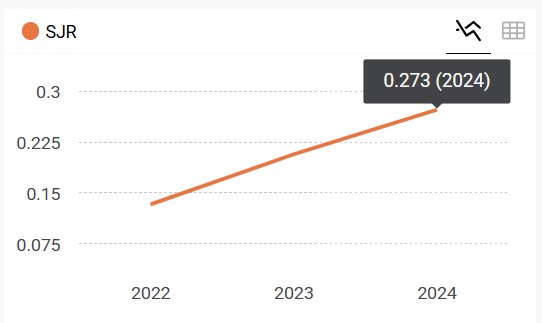Quartiles
| Quartile | Subject Area Category |
| Q3 | Applied Psychology |
| Q3 | Clinical Psychology |
| Q4 | Experimental and Cognitive Psychology |
Psikohumaniora's SJR progress
| Year | SJR |
| 2022 | 0.133 |
| 2023 | 0.207 |
| 2024 | 0.273 |

The Psikohumaniora logo* is derived from the psychological symbol "Ψ" as known as a trident or "trishul" (in Sanskrit), which is the 23rd Greek alphabet called "psi". The symbol is then duplicated and rotated 5 (five) times to make a 6 (six). The numbers 5 and 6 are important numbers in Islam, and they constitute the main core of science in UIN Walisongo where Psikohumaniora is part of it. The numbers 5 and 6 symbolize Rukun Islam (the five pillars of Islam), and Rukun Imam (the six pillars of faith).
Trident is a prominent psychological symbol; its three prongs carry multiple interpretations:
__________
* This logo was designed in 2016 and narrated by Helmi Suyanto (see e-Certificate of HAKI).
Ismail, A. I. (2012, July 31). Inilah 3 jalur penyucian diri. khazanah.republika.co.id. https://khazanah.republika.co.id/berita/dunia-islam/hikmah/12/07/31/m80dlf-inilah-3-jalur-penyucian-diri
Lapsley, D. K., & Stey, P. C. (2012). Id, ego, and superego. In Encyclopedia of human behavior (pp. 393–399). Elsevier. https://doi.org/10.1016/B978-0-12-375000-6.00199-3
Safri, A. N. (2011). Al-Qur’an sumber ideologi perdamaian (Studi tematik atas term Islam, Iman, dan Ihsan) [Unpublished master thesis]. UIN Sunan Kalijaga Yoyakarta. https://digilib.uin-suka.ac.id/id/eprint/6850/
Syukur, A. (2014). Insan kamil sebagai tujuan akhir (A. Hasan (ed.)). https://be-songo.or.id/insan-kamil-sebagai-tujuan-akhir/
| Quartile | Subject Area Category |
| Q3 | Applied Psychology |
| Q3 | Clinical Psychology |
| Q4 | Experimental and Cognitive Psychology |

| Year | SJR |
| 2022 | 0.133 |
| 2023 | 0.207 |
| 2024 | 0.273 |
|
Governing Body & Contact |
|
Editorial Policies |
Supported by RAJAWALI & PTIPD - UIN Walisongo Semarang - Indonesia
